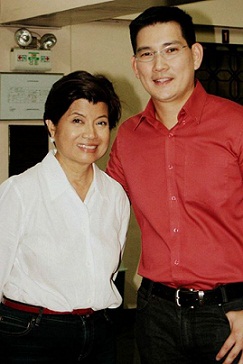By PABLO A. TARIMAN
 FRIDAY night last week, it seemed everyone who owns a TV set was glued on the final airing of the Channel 2 teleserye, “Ina, Kapatid, Anak” directed by Don M. Cuaresma and Jojo A. Saguin.
FRIDAY night last week, it seemed everyone who owns a TV set was glued on the final airing of the Channel 2 teleserye, “Ina, Kapatid, Anak” directed by Don M. Cuaresma and Jojo A. Saguin.
The evening audience profile surprisingly cut through and went up the usual CD audience categories with the educated class equally awaiting the dramatic ending.
It was a given that the masa was there as usual but it was also true that the other bulk of the teleserye watchers were public servants, working journalists and performing artists as well.
The big come-on was the highly competent cast led by Cherrie Pie Picache, Pilar Pilapil , Janice de Belen , Ronaldo Valdez with actors Enchong Dee and Xian Lim providing the “kilig” factors.
 The amazing discovery of this recently concluded teleserye is undoubtedly the new actor Alex Medina (son of Pen Medina and brother of Ping Medina). Even in a secondary role, Alex has the temperament, the intensity and highly expressive eyes that match the brilliance of the seasoned performers. In the final scene where he was asked by his father (John Regala) to kill his own sisters, he lets out a howl of despair the result of which drew admiration that rippled through facebook and twitter messages.
The amazing discovery of this recently concluded teleserye is undoubtedly the new actor Alex Medina (son of Pen Medina and brother of Ping Medina). Even in a secondary role, Alex has the temperament, the intensity and highly expressive eyes that match the brilliance of the seasoned performers. In the final scene where he was asked by his father (John Regala) to kill his own sisters, he lets out a howl of despair the result of which drew admiration that rippled through facebook and twitter messages.
It was a performance that eclipsed the characters of Xian Lim and Enchong Dee who remained the harmless matinee idols that they are.
A day after the closing chapter of “Ina, Kapatid, Anak,” it was timely that broadcast journalist Cheche Lazaro came up with a TV special analyzing the evolution of the Filipino teleserye.
Entitled “Si Ser Chief, Si Maya at Ang Teleserye,” the TV special gave both producers and audiences a bird’s eye view to what kinds of series would click and likely to be ignored.
Touted the most successful noontime teleserye and now headed for Malaysia, “Be Careful With my Heart” indeed had an audience acceptance that cut across ages, gender, social classes and race.
 “Be Careful With My Heart” Business Unit Head Ginny Ocampo said many things come into the making of a successful teleserye. “We have an active creative group that decides the direction to which the teleserye should go and what episodes need to be developed or discarded depending on the feedback we get from the audience.”
“Be Careful With My Heart” Business Unit Head Ginny Ocampo said many things come into the making of a successful teleserye. “We have an active creative group that decides the direction to which the teleserye should go and what episodes need to be developed or discarded depending on the feedback we get from the audience.”
Award-winning screenwriter Ricky Lee who is creative manager of ABS- CBN said the direction of the story almost always depends on the feedback they get from the audience. “Yes, we write the story but most of the inputs in the teleserye we also get from the audience. The teleserye villain gains popular acceptance when he or she becomes widely “hated” as in the case of Regala of “Ina, Kapatid, Anak.”
The Lazaro TV special traced the Philippine teleserye from the time of the “Gulong ng Palad” in the 50s to the reign of Janice de Belen and Judy Anne Santos as child stars of Philippine teleserye and the time the Filipino favorite soap operas invaded Brunei, Myanmar, China, Indonesia, Hong Kong, Singapore, Vietnam, Korea and Taiwan. It also analyzed the impact of the invasion of the Mexican teleserye import, “Marimar.”
 A showbiz watcher noted that before “Be Careful With My Heart,” other Channel 2 programs have already made a dent in the international scene with “Magkaribal,” “Prinsesa ng Banyera,” “Dahil May Isang Ikaw,” “Impostor,” “Imortal,” “Budoy,” “Iisa Pa Lamang,” and “Mara Clara.” It may be noted too that “Pangako Sayo” starring Jericho Rosales and Kristine Hermosa was a big hit in Cambodia, among other Asian countries.
A showbiz watcher noted that before “Be Careful With My Heart,” other Channel 2 programs have already made a dent in the international scene with “Magkaribal,” “Prinsesa ng Banyera,” “Dahil May Isang Ikaw,” “Impostor,” “Imortal,” “Budoy,” “Iisa Pa Lamang,” and “Mara Clara.” It may be noted too that “Pangako Sayo” starring Jericho Rosales and Kristine Hermosa was a big hit in Cambodia, among other Asian countries.
In the same Lazaro TV special, De Belen and Santos looked backed to their child star days.
“What the TV audiences didn’t know was that when the soap opera rated high, it also meant working every day and shooting until five in the morning. I will just get a short nap and then I proceed to school later without much sleep,” Santos said.
She admitted her early stints in teleseryes allowed her to learn how to “cry” at a drop of a hat. “What I remember was that I was always crying all the time because the villain keeps badmouthing me with ‘sabunutan’ (hair-pulling) highlighting most of my scenes.”
In her new teleserye, Santos said she asked the creative people not to reprise her crying scenes in the old teleserye. “I think the teleserye audiences now have come of age and you can’t offer them the same stuff they enjoyed in the 70s and 80s,” she said.
As to why Filipinos love teleseryes, sociologist and theater director Ricky Abad said the Philippines is a country that simply loves good story-telling. “Sometimes the plot would look familiar and when you looked closely, you realize the scenes were reminiscent of ‘Romeo and Juliet’ and ‘Count of Monte Cristo.’ But since teleseryes cut through a wide segment of audiences, I think we should trying using teleseryes as an educational tool to change attitudes.”
Well, as an American wag would say, “Soap opera seems to be a dirty word, but actually they are the most popular shows we have. People want to know what happens next, people hate the villains and love the lovers. It’s good, fun TV.”
